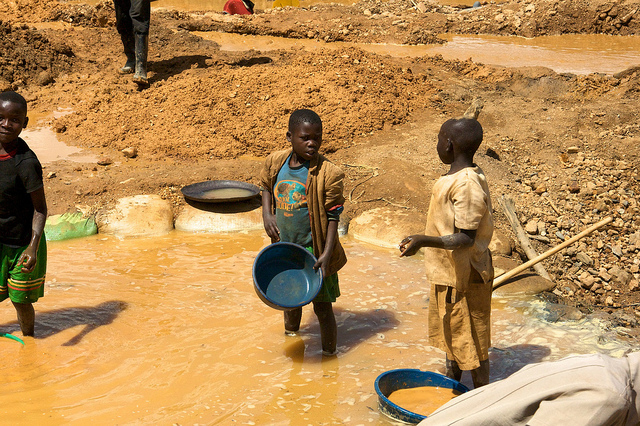Poverty & Child Laborers in the Democratic Republic of the Congo

Mineral resources abound in the Democratic Republic of the Congo, yet this apparent blessing has caused the problematic use of child labor in mines. The UNICEF estimates 40,000 child laborers in the Democratic Republic of the Congo (DRC) mine for the resources enjoyed by the rest of the world.
Recently, human rights activists have protested the employment of the Democratic Republic of the Congo’s artisanal miners because of reports of extremely poor working conditions. Additionally, the artisanal miners produce an estimated 10 to 25 percent of the world’s supply of cobalt, a mineral necessary for many electronic devices.
The issue of child laborers in the DRC is connected to the country’s poverty in nine ways:
- The Democratic Republic of the Congo’s colonial past has caused enduring conflict and political stratification, creating avenues for the exploitation of children. The distance between those in power and the Congolese has persisted over the years. King Leopold of Belgium never visited his territory, yet used its resources. Joseph Kabila has been president since 2001 and has refused to leave office. In 2016, he banned public protests to restrict the voice of most Congolese. The Democratic Republic of the Congo’s colonial roots have led to unrest, like the civil war from 1997 to 2003. Improving the lives of its citizens has not been a priority, and they remain in poverty and in underpaid, brutal working conditions. In 2014, the country had the highest rate of extreme poverty in the world due in large part to instability from political clashes and the abuse of children.
- Current exploitation of children for the world’s supply of cobalt is only the newest indignity in a long history of misuse. Beginning with colonization, this naturally rich country has become poor because so many countries have simply taken what they wanted. For example, its rubber trees fueled the Industrial Revolution in Europe and the U.S. in the 19th and early 20th centuries. What basically constituted slave labor accomplished the extraction of rubber, a precursor to today’s exploitation of child laborers in the Democratic Republic of the Congo to fuel technological innovation.
- When the Democratic Republic of the Congo was a colony, Belgium failed to regulate education. This left the country undeveloped and at the mercy of exploitative, low paying jobs. Belgium left education to missionaries, whose numbers were too few to educate the majority. Out of a population of 13 million, there were 16 university graduates by 1960, allowing very few Congolese the opportunity to break the cycle of exploitation.
- In independence, The Democratic Republic of the Congo still has not prioritized education, funneling more children into the mines. The country’s constitution guarantees a free elementary education, but poverty and instability in the Democratic Republic of the Congo have allowed very few schools in rural mining areas and with few other options, children as young as four go to work in the mines.
- The money children make in the mines often constitutes a primary source of income for their families. Child laborers in the Democratic Republic of the Congo only receive $2 to $3 per day.
- Mining causes death, injury and birth defects, propagating the poverty that caused the exploitation of child laborers. From the infants strapped to their mothers’ backs to the children working on their own, miners are exposed to toxic metals that cause breathing problems and birth defects. For example, miners in the southern areas of the Democratic Republic of the Congo were found to have urinary cobalt concentrations that were 43 times the levels found in a control group. Birth defects occur that are so rare they have only ever been found in the Democratic Republic of the Congo. Additionally, no standardized safety equipment or procedures exist. In the resource-rich province of Katanga, an average of 6.6 children die a month from soil collapses caused by deep digging.
- The importance of cobalt in modern technology has only worsened exploitation as developed countries continue to take the Democratic Republic of the Congo’s resources. Cobalt is necessary to create lithium-ion batteries found in cell phones, laptops and electric cars. A battery for an electric car can require up to 15,000 grams of lithium-ion. As the most expensive raw material in these new batteries, it follows that cheap labor would be prioritized, leading to the exploitation of children.
- The Democratic Republic of the Congo has become economically dependent on these minerals and the children who mine them for little pay. While the country mines a variety of minerals, it is cobalt that the world depends on.
- Because the Democratic Republic of the Congo has been politically turbulent and poor, a lack of transparency in cobalt’s global supply chain exists. Cobalt is purchased by Chinese firms in the country and then sold to outside technological manufacturers like Apple Inc., Microsoft Corp., Tesla, Inc. and Samsung. While law requires American companies to verify the origins of minerals from the Democratic Republic of the Congo, cobalt is not one of the named conflict minerals and thus exempt from this law.
The good news is, as the technology requiring cobalt becomes more prominent, many have protested this exploitation and made positive changes. In addition, here are some positive moves by several large corporations:
- Apple cut ties with one of its largest artisanal cobalt suppliers because of the abuse of child laborers in the Democratic Republic of the Congo. Apple claims to internally consider cobalt as a conflict mineral.
- Microsoft has publicly claimed a lack of tolerance for child labor for its cobalt.
- Samsung and Tesla claim increased efforts in documenting supply chains.
If these companies continue refusing to condone the exploitation of children in mines, hope exists for child laborers in the Democratic Republic of the Congo.
– Charlotte Preston
Photo: Flickr
